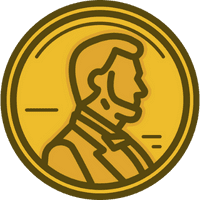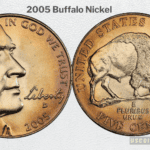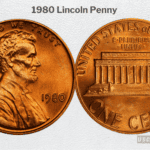In today’s segment on rare and old collectible banknotes, we will talk about the 1976 2-dollar bill.
As history has it, the 2-dollar bill was nicknamed the “dirty tom” in the 1900s because of its association with gambling, bribery, and prostitution. This negative reputation made it difficult for the bill to gain popularity among Americans.
But all that changed in 1976, when the 2-dollar bill got reintroduced to America after undergoing a significant makeover.
Most 1976 2-dollar bills cost $2 in circulated condition. In uncirculated conditions, a sample can cost anywhere from $2.50 to $15. However, uncirculated bills with higher grades, like PMG 69 can sell for as much as $1,200.
If you have a 1976 2-dollar bill burning a hole in your pocket, this article will help you determine if the banknote is worth more than its face value.
In this piece, we’ll dive into various aspects of this cool bicentennial bill, including:
- History
- Design Elements
- Value Chart
- Varieties and Errors
So, let’s kick start our post with the fascinating history of the 1976 2-dollar bill.
1976 2 Dollar Bill History and Significance
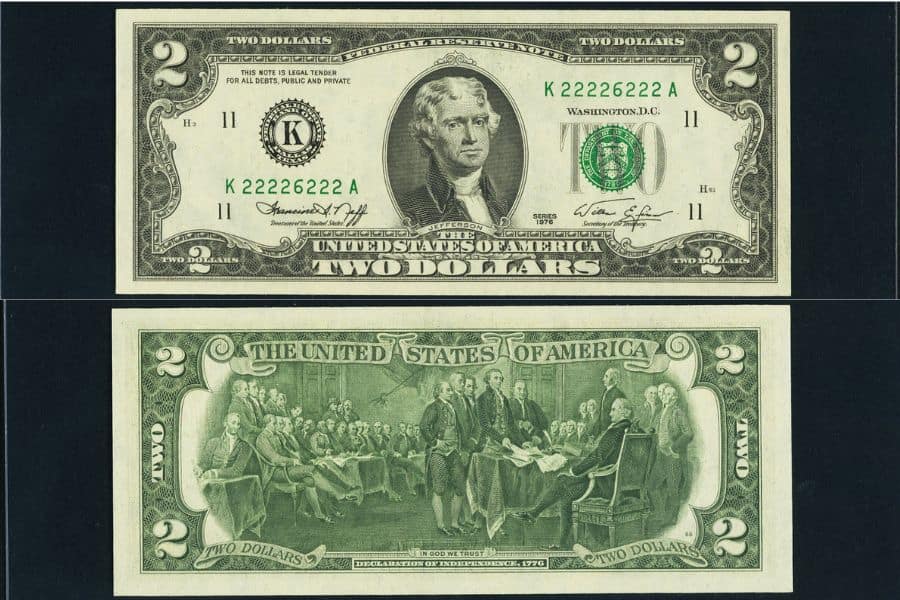
What do you know about the year 1976?
It’s the year that Steve Jobs and Steve Wozniak founded Apple Computer. The same year, the NBA and ABA merged, and Jimmy Carter became the 39th president of the United States.
But perhaps one of the most significant milestones in 1976 was the celebration of America’s 200th birthday. The U.S. treasury marked this significant event by reintroducing the $2 bill with a fresh design.
However, if we want to understand this bill, we have to go back to where it all began.
In 1862, the U.S. treasury introduced its first paper currency, which included the 2-dollar paper money (printed as a legal tender note).
At the time, most Americans preferred using coins as currency, which explains why the paper bill took time to catch on. It is also important to note that a typical laborer in the 1860s earned less than $15 monthly, and most products and services cost less than a dollar.
Although the 2-dollar bill represented a decent amount, most people didn’t know what to do with the currency. But over time, the legal notice saw increased use, as inflation reduced the value of paper money.
A century later, the $2 bills fell away from use and became non-existent in circulation. One reason for this is its association with political bribes and gambling.
Besides its less-than-innocent reputation, there were the issues of practicality. Most Americans opted to carry around and use $1 and $5 bills rather than $2 notes.
After undergoing several design changes to make it more appealing to people with no success, the Federal Reserve eventually halted the printing of 2-dollar notes in 1966.
The 1976 United States Bicentennial provided a new opportunity for the 2-dollar bank note to make a comeback after 10 years of hiatus in its production. The new banknotes featured a fresh design that captured the essence of America’s journey over the past two centuries.
Like many bicentennial coins, many Americans hoarded the 1976 $2 notes because they deemed it special and too beautiful to spend. Others believed the bills held more value than their face value.
1976 2 Dollar Bill Design
As mentioned above, the 2-dollar bill underwent many redesigns to make it more appealing to Americans.
The Federal Reserve made the last significant design change to the note in 1953, closely resembling the $5 paper money. The new note featured a resized Treasury seal and missed the words “United States of America”.
This change caused a dip in the popularity of the $2 note. In an effort to save it, the words “In God We Trust” were introduced in 1963. Sadly, this alteration had no impact, and finally, the bill was discontinued until 1976.
And now, let’s break down the design details of the 1976 2-Dollar Bill, also known as the Bicentennial Two.
Obverse Design
Thomas Jefferson, the founding father of America, takes center stage on the obverse of the 1976 2-dollar bill. The portrait of Jefferson acknowledges his pivotal role in the Declaration of Independence and as the third U.S. President.
The inclusion also serves as a tribute to his contribution to American history and enduring legacy as a philosopher, statesman, diplomat, and lawyer.
Upon closer look at the portrait, you will notice the engraver captured Jefferson’s thoughtful and contemplative expression. The late president also faces right and rocks his signature powdered wig and period attire.
Apart from the center image, the bill includes two serial numbers: one on the bottom left and the other on the upper right of the picture.
The letter at the beginning and the end of the serial number (usually ranging from A to L) stands for the Federal Bank the printed the note. On the other hand, the numbers show the place and the year the $2 bill was printed.
Another design aspect worth mentioning is the seals on the right and left sides of the image. The former represents the treasury seal (colored green) and the latter includes the name and abbreviation of the distributing bank.
As for the two signatures, one is for the U.S. treasurer and the other for the Tressure secretary. The signatures make the $2 bill a legal tender.
For the year 1976, the signatures on the $2 bill belonged to:
- US Treasurer – Francie Irving Neff
- Treasury Secretary – William Simon
Reverse Design
The reverse of the 1976 2-dollar bill depicts a painting of the drafting of the Declaration of Independence designed by John Trumbull. This image replaced the previous reverse design which displayed the expansive, beautiful Monticello Estate, the home of Thomas Jefferson.
Trumbull’s painting depicts a pivotal moment when the founding fathers signed the declaration for the birth of their nation.
Although the original image featured 47 men signing the document, only 42 men appeared on the 1976 2-dollar bill due to space constraints.
Another design element appearing in the reverse is the words “THE UNITED STATES OF AMERICA” on the top. The denomination “TWO DOLLAR” falls on the bottom left and right side of the bill.
And if you look at the bottom of the note, you will notice the motto “IN GOD WE TRUST” as well as the statement “DECLARATION OF INDEPENDENCE, 1776”.
1976 2 Dollar Bill Additional Details
- Category: Thomas Jefferson
- Type: Federal Reserve Note
- Producer: The U.S. Bureau of Engraving and Printing
- Denomination: $2.00 U.S. Dollar
- Series: One
- Mintage: 590,720,000
- Mint: Washington, DC
- Obverse Design: N/A
- Reverse Design: John Trumbull
- Composition: 75% cotton, 25% linen
- Seal Variety: Green
- Security Features: Red and Blue Fibers, Raised Printing
1976 2 Dollar Bill Varieties and What Makes Them Valuable
| 1976 $2 Bill with Green Seal | 1976 $2 Bill Star Note | |
| Circulated | $2 – $10 | $2 – $7 |
| Uncirculated | $15 | $8 – $30 |
| PMG 66 | $50 – $200 | $55 – $85 |
| PMG 69 | $375 – 1,200 | $2,000 – $25,200 |
Despite their beauty and historical significance, 1976 2 – dollars might not make you the richest man in the world.
The Federal Reserve printed 590,720,000 $2 bills between 1976 and 1978. And to date, you can find the $2 notes from the 1976 series in circulation. For this reason, they’re not as rare as you might have anticipated.
The reason many people believe the 1976 $2 bills are scarce is because no one uses them in everyday transactions for several reasons.
In fact, there are so many cases of individuals getting arrested for using these banknotes. Case in point, Danesiah Neal, a 13-year-old eighth grader, got arrested for trying to pay for her lunch using a $2 bill she got from her grandmother.
Since these bills have a unique makeup consisting of fibrous materials, they’re not compatible with anticounterfeiting test pens. As a result, they often get flagged as counterfeit.
Now, let’s discuss the different 1976 $2 bill varieties and thier values:
1976 $2 Bill with Green Seal
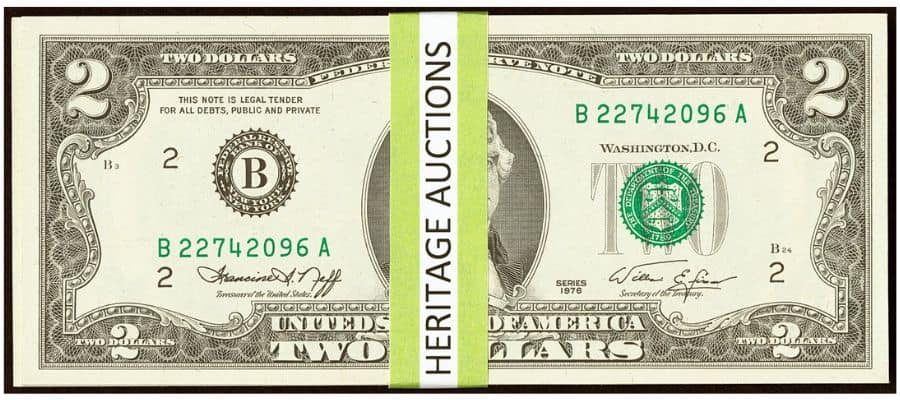
In terms of value, a circulated 1976 $2 note with no special markings, errors, or other oddities can fetch only $2 on the market.
However, an uncirculated sample can sell anywhere from $2.50 to $15. If it has a higher grade, let’s say PMG 69, the bill can bring in around $1,200.
Individuals with a crisp, uncirculated original pack of 100 notes can sell it for around $375 or even more.
1976 $2 Star Notes
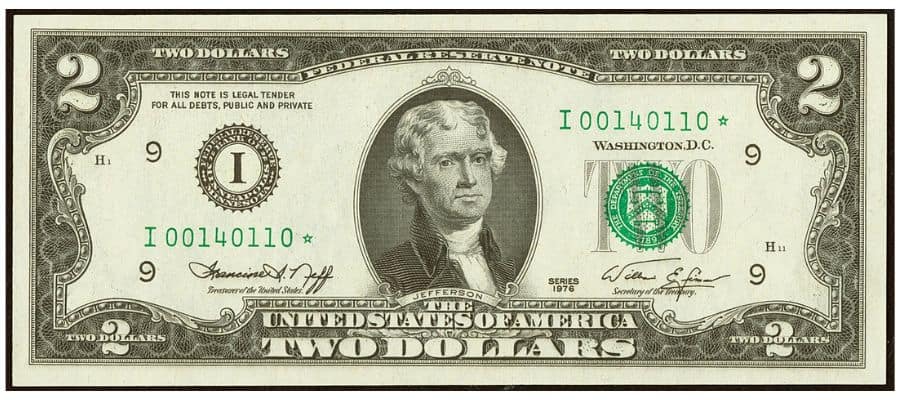
As the name suggests, 1976 $2 bill star notes feature a star (*) at the end of the serial number, instead of the usual letter.
The star indicates that the Federal Reserve Bank replaced the note due to a misprint or other printing issues.
1976 two-dollar star notes often have a higher value than regular 2-dollar bills, especially those printed in Kansas City and Minneapolis.
In circulated condition, a $2-star note can sell for approximately $8 to $10. But if you have an uncirculated piece in a higher grade (e.g., MS 66 to 69), it can cost between $85 and $2,000.
A crisp uncirculated original pack of 100 1976 $2 star bill can fetch you as much as $15,275. Check out this near-complete set of start notes which fetched $350 in 2008.
1976 $2 Stamped Bills
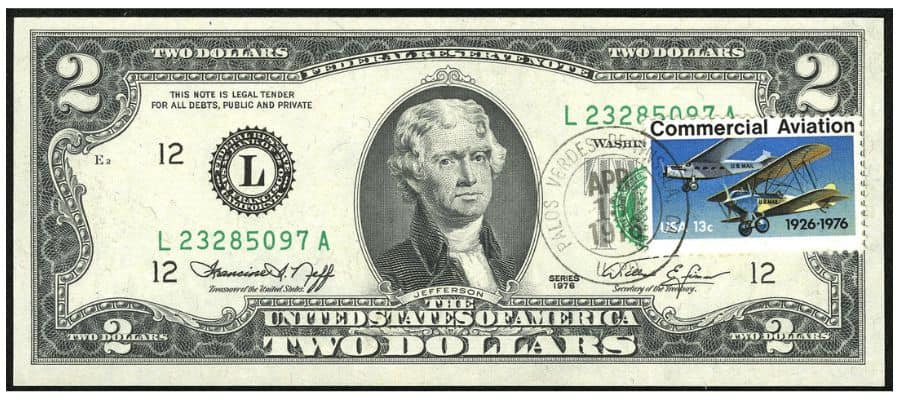
The 1976 $2 stamped note is not a variety of the 1976 2-dollar series per se. It emerged when people took their bicentennial notes to their local post offices on the release day, April 13, to get them stamped with the 1976 date.
These individuals believed the notes would be a unique, one-off issue. Unfortunately, the Federal Reserve continued to produce the $2 bills until 1978.
The good news is that stamped 1976 $2 bills in good condition cost more than regular 2-dollar notes.
Some collectors are willing to pay more, particularly for bills from their hometown or a location of personal importance. For instance, this first-day issue 1976 $ 2-dollar bill sold for $32 in December 2011 at Heritage Auctions.
1976 $2 Serial Numbers
Palindromes refer to serial numbers that read the same way, forward or backward, i.e. A12344321.
1976 2-dollar notes with these serial numbers are super rare and tend to fetch a premium in the market. Some can sell for approximately $95 or more.
On the other hand, ladder notes have two serial numbers on the obverse that appear in a sequence, like 12345678. As for the reverse ladder, the serial number sequence starts from eight and ends at one, e.g., 876543210.
Like Palindrome bills, ladder banknotes are extremely rare, with one appearing in every 96 million bills. Because of this, they often fetch a high premium at auctions. Reverse ladder bills are less desirable and cost less than ladder notes.
Other interesting serial number combinations include:
Solid Serial Numbers
These are those serial numbers with a single digit repeating throughout the sequence, i.e., A99999999A and A11111111A. Most collectors find these notes attractive, and they tend to fetch a high market value.
Double Quad Serial Number
Another fancy serial number that collectors look for in 1976 $2 bills is the double quad serial number. Notes with these serial numbers have four identical digits in the first half of the sequence. The second half features four different identical numbers too. For example, 88883333 and 1111444.
These notes are super rare and only occur 90 times in a run of 99,999,999 sequential notes. In uncirculated condition, they can cost anywhere from $50 – $200.
Low Serial Number
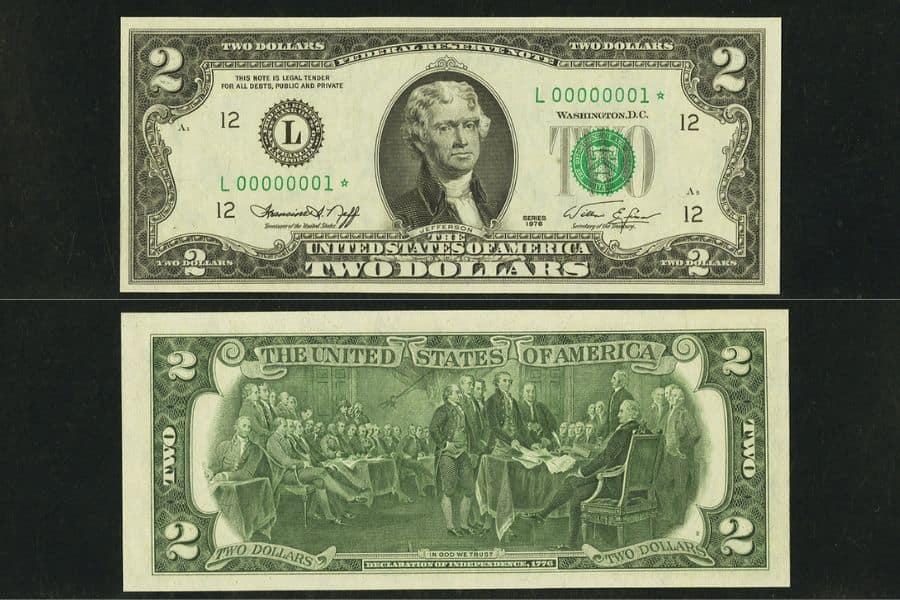
These 1976 two-dollar bills feature serial numbers with lots of leading zeros, like 00000001 or 00000007. If you have such a note, you might want to check with an expert collector. Who knows! You might have a rare piece in your hand.
As a fact, 1976 $2 notes with low serial numbers can fetch you up to $29,000 in good condition. If it’s a star note, you can get as much as $35,000.
Consecutive Serial Numbers
You should also be on the lookout for 1976 $2 bills with consecutive serial numbers. While they might not be super rare, some collectors find them interesting and can pay good money for them.
Some examples of this serial number include:
- A00123456A
- F98765432A
- B12345678A
As you can see, these serial numbers feature digits that come before or after each other.
1976 $2 Bill Uncut Sheet
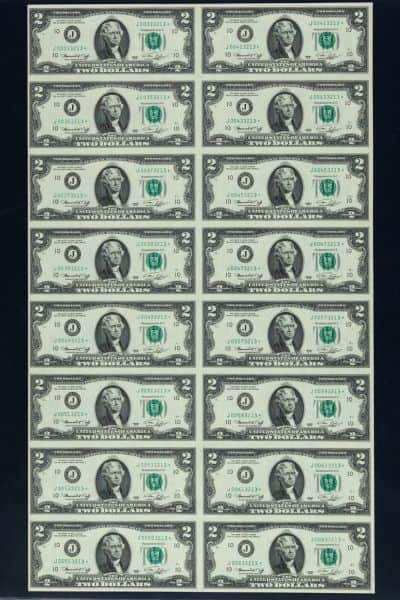
During the production of paper money, currency bills are printed on large sheets, featuring multiple bills. Later, these sheets get separated into individual notes so they can enter circulation. But sometimes, the Issuer might sell the uncut sheet to numismatics.
Depending on their rarity and condition, uncut currency sheets could typically have a higher value than the total face value of each cut bill.
For example, this uncut sheet of 16 1976 $2 bills sold for around $384 in 2017. Another similar piece sold for $930 in 2019.
1976 $2 Bills Original Pack
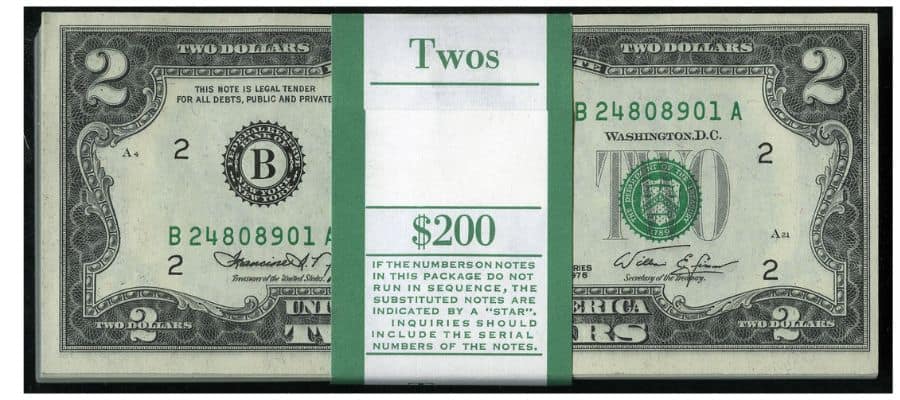
Like uncut sheets, issuers also sell packs of notes as collector items. These packs could include several uncirculated bills. You can also find packs consisting of multiple circulated 1976 $2 notes.
As for thier value, it varies depending on factors like rarity, consecutive serial numbers, or demand among collectors.
The value of an original pack of 1976 $2 notes can range from $100 to $276 or more. In crisp uncirculated condition, a pack could cost around $51.
1976 2 Dollar Bill Errors List
While most 1976 two-dollar bills sell for $2, a few notes can fetch thousands of dollars because of their uniqueness. They include:
1976 $ Bill Inverted Overprint Error
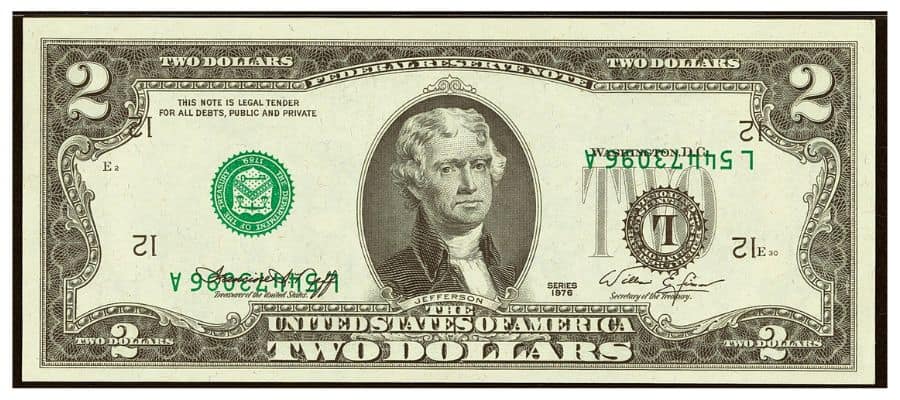
The U.S. Federal Reserve uses overprint to add design elements like serial numbers and seals when printing banknotes. But sometimes, the sheets of banknotes can get oriented incorrectly, resulting in an inverted overprint error.
Although the overprint is on the correct side of the bill, you will notice that the seals and serial numbers appear upside-down. But the back of the note will appear normal.
If you have an uncirculated 1976 $2 bill with an inverted overprint error, expect to make over $1,000 in auctions. For example, one such banknote graded PMG 68 sold for $2,760 in January 2021 at Heritage Auctions.
1976 $2 Bill Double Overprint Error
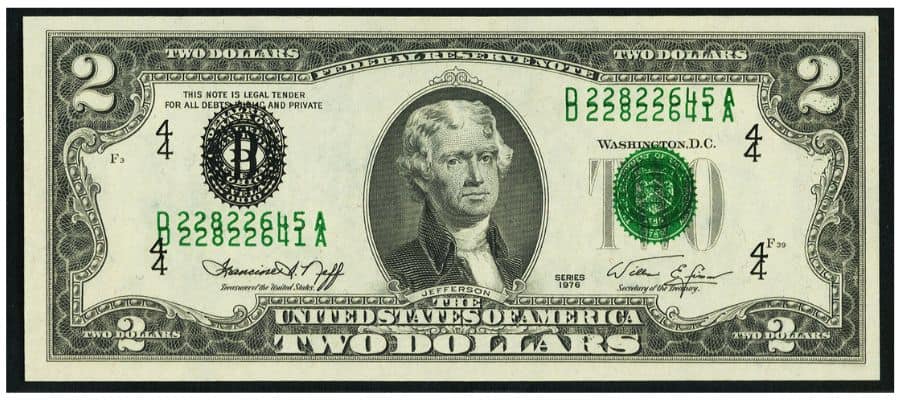
The double overprint error is another mistake that occurs during the third printing process. It happens when the bill is accidentally printed with two layers of ink, causing a double image or overprint of design details.
1976 $2 bills with this error have an intriguing visual appeal that makes them unique and sought after by collectors. As a fact, some currency enthusiasts can pay as much as $10,000 for this error bill. For instance, a collector paid $18,000 for a 1976 $2 bill graded PMG 65 in 2020.
1976 $2 Bill with Blank Reverse(Missing Back Printing)
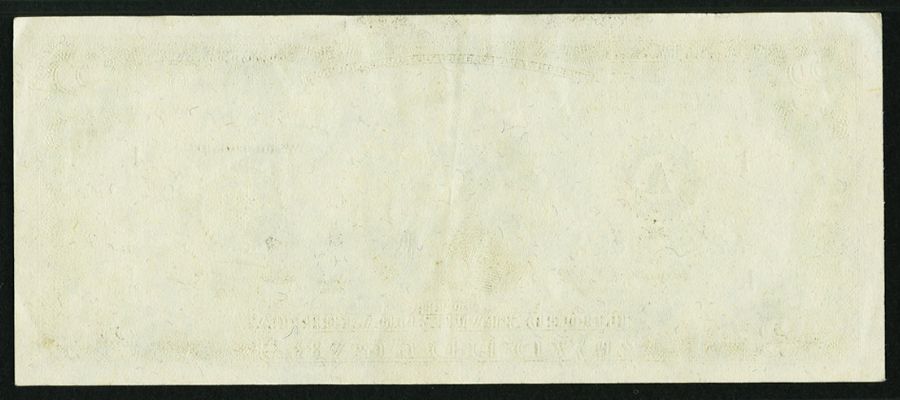
As the name suggests, the bill’s reverse is devoid of any design elements. This error can occur because of a misalignment of printing plates or an error during the printing process, which leaves the reverse side blank.
One such note sold for about $3,600 at Heritage Auctions on Sep 8, 2017.
1976 $2 Bill Fold-Over Error
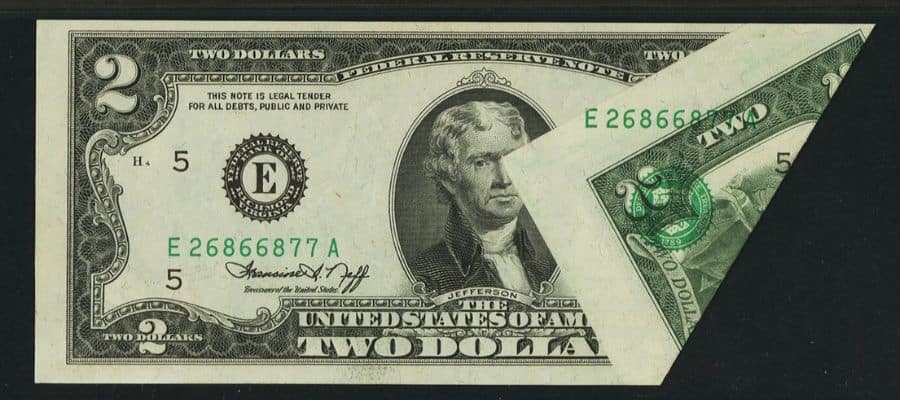
Fold-over errors on the 1976 two-dollar notes are super rare. These errors occur when an uncut sheet of paper money is creased or folded during the printing process. As a result, the green seal and serial numbers are printed on both the front and back of the bill.
Fold-over errors are highly sought after by collectors and enthusiasts due to their uniqueness. If you have this type of error note, you can get around $2,350 in auctions.
1976 $2 Bill Misalligned Serial Number Error
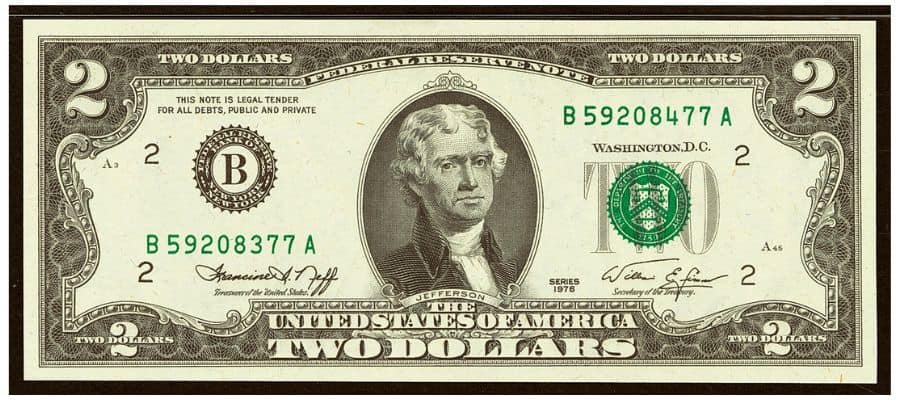
The mismatched or misaligned serial number error is usually not noticeable at first glance, unless, you look closely at the two serial numbers.
For example, on this 1976 $2 error note, you will notice two different serial numbers. At the lower left of Jefferson’s face, we have B59208377A. On the upper right, the sequence reads as B590208477A.
You can get yourself this error note at Heritage Auctions for about $750.
1976 2 Dollar Bill FAQs
How Can You Tell if A $2 Bill Is Rare?
Contrary to belief, 1976 $2 bills are not rare. They’re just not used in everyday transactions because of their dark history and impracticality.
But that’s not to say they are no rare pieces. If your bill has an overprint error, whether inverted or double design details, it can fetch you some good money. The same applies to notes with special markings (like stars) and unique serial numbers.
What Is the Most Valuable 1976 $2 Bill?
The most valuable 1976 $2 bill sold for $35,250 in 2016 at Heritage Auctions. The near-gem star note printed had a low serial number – L00000001. Another similar star note brought in $29,900 in 2009.
As you can see $2 notes with rate serial numbers often fetch higher premiums in Auctions. You can say the same for bills with overprint errors.
